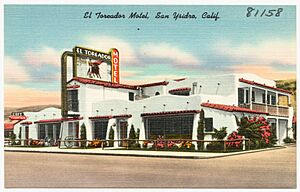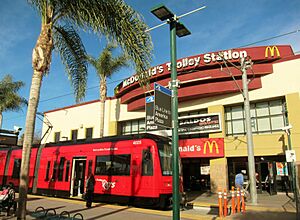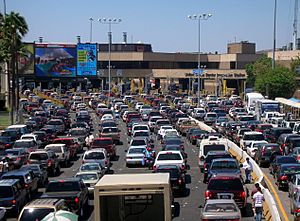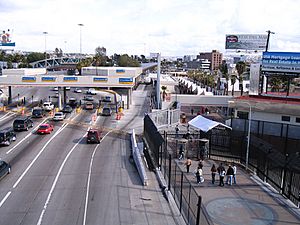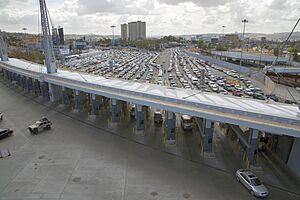San Ysidro, San Diego facts for kids
Quick facts for kids
San Ysidro, San Diego
|
|
|---|---|
| San Ysidro | |
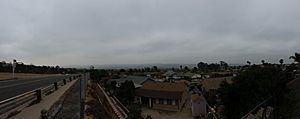
San Ysidro seen from south of California State Route 905
|
|
| Country | |
| State | |
| County | |
| City | |
| Population
(2010)
|
|
| • Total | 28,008 |
| ZIP code |
92173
|
San Ysidro is a community located in the city of San Diego, California. Its name comes from the Spanish for "Saint Isidore". San Ysidro is right next to the Mexico–United States border. It is part of South San Diego, which is a bit like a separate part of the city. Important streets here include Beyer Boulevard and San Ysidro Boulevard.
Contents
History of San Ysidro
Early Days: Rancho Tía Juana (1829–1848)
After Mexico became independent from Spain in 1822, the Mexican government started giving out large pieces of land called ranchos. In 1829, Santiago Argüello Moraga received a 10,000-acre rancho called Tía Juana. This land included parts of what are now San Ysidro and Tijuana.
His son, Emigdio Argüello, got the nearby Rancho Melijo in 1833. They built a house called "La Punta" there. For many years, this was one of the only buildings in the area.
Becoming a Border Town (1848–1922)
After the Mexican-American War in 1846, Mexico gave up a lot of land to the U.S. in 1848. This is how San Ysidro ended up right on an international border. The border was officially marked in the mid-1860s. The first building for customs (where goods are checked) was built in 1873. A fence was put up along the border in 1910.
Tia Juana City: A Short-Lived Town (1887–1895)
In 1885, San Diego got connected to the U.S. railroad system. This caused a big boom in real estate. In 1887, a company called Hart and Stern created a town called Tia Juana City. It was located where the Las Americas Premium Outlets are today. This town had one street with a drug store, a saloon, a hotel, and a boot shop. There were also a few houses scattered around.
However, floods in 1891 and 1895 washed away many buildings. Tia Juana City was not rebuilt right away, and people moved to higher ground.
The Little Landers Colony (1908–1916)
William Ellsworth Smythe started a special community in 1908 called the Little Landers. Their motto was: "A little land and a living surely is better than desperate struggle and wealth possibly."
- Shared Land: Each person in the community had a small plot of land, usually about 2 acres. This was just enough land for them to farm themselves.
- Equal Voice: Everyone had an equal say in how the community was run. A board of directors, chosen by the community, handled business.
- Cooperative Farming: All the farming products were bought and sold together as a group.
- Community Funds: Money from land sales helped pay for public things like a library, a park, and irrigation systems.
- Products: Besides vegetables, they also raised and sold ducks, rabbits, and goats.
The Little Landers community was one of the first communes in the United States. It ended when a big flood destroyed their farms in 1916. The George Belcher homestead is the oldest building still standing in San Ysidro today. George Smythe gave the new settlement the name San Ysidro, which was an older way of spelling Saint Isidore the Laborer's name in Spanish.
Growing as a Border Community (1922–1957)
In the 1920s, Tijuana, Mexico, became a popular place for racing, gambling, and entertainment. Many Americans who worked at these places lived in San Ysidro and crossed the border for work. By 1922, about twenty new homes were built in San Ysidro for these workers.
In 1924, the San Ysidro Free Public Library opened. A community leader named Frank Beyer donated the land and money for it. The San Ysidro Community Church, designed by Louis John Gill, also opened in 1924. The Our Lady of Mount Carmel Catholic Church opened a few years later. The San Ysidro Bank and the Civic and Recreation Center opened in 1925. In 1931, a new, historic customs building replaced the old one.
After 1933, alcohol became legal again in the U.S. Also, gambling was made illegal in Mexico. This meant fewer Americans visited Tijuana. Some homes in San Ysidro were then bought by Mexican citizens who worked in the U.S. After World War Two, there was a housing shortage in San Diego. Many new houses, apartments, and bungalow courts were built in San Ysidro.
At this time, San Ysidro was seen as a "full-fledged city." It had everything its residents and visitors needed for their daily lives.
Becoming Part of San Diego (1957-Present)
Annexation by San Diego
In 1957, San Ysidro and the rest of South San Diego officially became part of the city of San Diego. Some residents tried to reverse this decision in 1973, but they were not successful.
1984 McDonald's Incident
On July 18, 1984, a very sad event happened at a McDonald's restaurant. A man opened fire, causing a lot of harm. Twenty-one people lost their lives, and nineteen others were hurt. A special police team ended the situation. The McDonald's building was taken down in 1985. Today, a Southwestern College campus is on that site. This event was a very serious incident in California's history.
Climate in San Ysidro
| Climate data for San Ysidro, San Diego | |||||||||||||
|---|---|---|---|---|---|---|---|---|---|---|---|---|---|
| Month | Jan | Feb | Mar | Apr | May | Jun | Jul | Aug | Sep | Oct | Nov | Dec | Year |
| Record high °F (°C) | 89 (32) |
96 (36) |
95 (35) |
99 (37) |
102 (39) |
112 (44) |
109 (43) |
108 (42) |
111 (44) |
103 (39) |
98 (37) |
89 (32) |
112 (44) |
| Mean daily maximum °F (°C) | 68 (20) |
68 (20) |
70 (21) |
71 (22) |
73 (23) |
77 (25) |
81 (27) |
83 (28) |
82 (28) |
78 (26) |
73 (23) |
68 (20) |
74 (23) |
| Mean daily minimum °F (°C) | 45 (7) |
47 (8) |
49 (9) |
52 (11) |
56 (13) |
59 (15) |
63 (17) |
64 (18) |
63 (17) |
57 (14) |
49 (9) |
45 (7) |
54 (12) |
| Record low °F (°C) | 22 (−6) |
24 (−4) |
29 (−2) |
35 (2) |
39 (4) |
42 (6) |
48 (9) |
50 (10) |
44 (7) |
30 (−1) |
28 (−2) |
22 (−6) |
22 (−6) |
| Average precipitation inches (mm) | 2.56 (65) |
2.33 (59) |
2.50 (64) |
0.86 (22) |
0.24 (6.1) |
0.09 (2.3) |
0.03 (0.76) |
0.11 (2.8) |
0.28 (7.1) |
0.47 (12) |
1.22 (31) |
1.40 (36) |
12.09 (307) |
San Ysidro has a mild climate. It generally has warm summers and cool winters. The area does not get much rain, especially during the summer months.
Border Crossing and Its Importance
San Ysidro is home to one of the busiest land border crossings in the world. It is the second-busiest crossing between two countries and the busiest in the Western Hemisphere.
- Traffic Volume: In 2019, over 15 million vehicles and 36.7 million people entered the United States here.
- Commuters: Most people crossing are workers from Tijuana who travel to jobs in San Diego and Southern California.
- Reverse Traffic: People also cross into Mexico for work in factories (called maquiladoras) or for services and entertainment in Tijuana.
- Wait Times: In 2009, waiting times for cars to enter the U.S. could be 1.5 to 2 hours during busy times. For people walking, waits could be over two hours in the morning.
- Pedestrian Crossings: In 2016, a second pedestrian crossing called "PedWest" opened. It connects Plaza Viva Tijuana in Mexico to Virginia Avenue in San Ysidro.
- No Trucks: Large trucks cannot use the San Ysidro crossing. They must use the Otay Mesa Port of Entry instead.
The San Ysidro Land Port of Entry Expansion Project was completed in 2019. This project cost $741 million. It made the crossing bigger and improved the inspection areas for vehicles and pedestrians.
Population and People
The 2010 census counted 28,008 people living in San Ysidro. About 93% of these residents were of Hispanic background.
When looking at people over 5 years old:
- 60% spoke both Spanish and English well.
- 13% spoke only Spanish.
- 10% spoke only English.
Community Services
Police Services
The San Diego Police Department helps keep the community safe. They have a main office and a smaller substation in San Ysidro.
Fire and Medical Help
The San Diego Fire Department provides fire and emergency medical services. Fire station 29 serves the area.
Education for Kids and Teens
Local Schools
Children in San Ysidro attend schools run by two districts:
- The San Ysidro School District serves students from kindergarten through eighth grade.
- The Sweetwater Union High School District serves high school students.
San Ysidro High School serves most of the community. Some parts of San Ysidro are zoned for Southwest Senior High School or Montgomery High School. The San Ysidro Adult Education Center also offers classes for adults.
Landmarks and Places to Visit

- Library: The San Diego Public Library has a branch in San Ysidro.
- Parks: You can visit Howard Lane Park, Vista Terrace Park, and San Ysidro Community Park.
- Churches: Our Lady of Mount Carmel Roman Catholic Church is one of the local churches.
- Post Office: The San Ysidro Post Office has been serving the community since 1910, though it has moved locations.
- Historic Building: The U.S. Inspection Station/U.S. Custom House is a historic building listed on the National Register of Historic Places.
- Shopping:
Las Americas Premium Outlets is San Diego's largest outlet mall. It has 125 stores and is right on the international border.
- Art Gallery: The building at 147 W. San Ysidro Blvd. was designed by famous architect Louis John Gill. It used to be the San Ysidro Commercial Company and is now TheFront art gallery.



